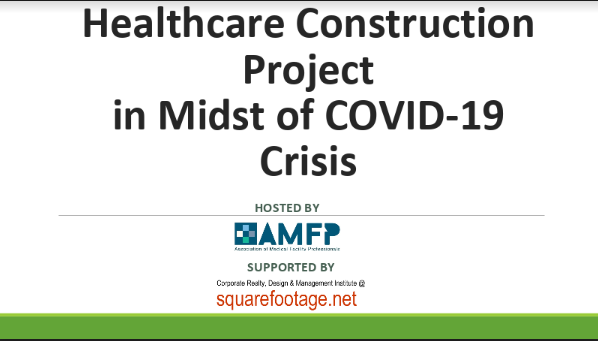
By Megan Headley
Healthcare construction hasn’t stopped under the COVID-19 pandemic, but it has dramatically evolved. As it becomes increasingly more difficult to find available real estate needed to support the incoming surge while separating patients infected with COVID-19 from those without, many hospital systems are working through existing projects.
Mike Wood, M.D., Ph.D., MSM, CHC, vice president of construction for Medxcel and immediate past president of the Association of Medical Facility Professionals (AMFP), explained during the April 2 AMFP webinar, “Managing Your Healthcare Construction Project in Midst of COVID-19 Crisis,” that his team is leading a task force for client Ascension Health to assess design and construction of projects already underway and determine which of its 3,700 projects needed to be completed to support the coming surge of patients with respiratory distress.
The task force ultimately opted to maintain full momentum on work in progress around critical systems, including critical patient care areas such as ICUs and ORs, elevators, MEP, HVAC, building automation systems and any potential additional bed projects. The bigger question was how to maintain full momentum as the health system braces for overwhelm and implemented new requirements for infection control. “We thought that was not such a brave decision as one of necessity and business continuity,” Wood says. “What we’ve found in the weeks since was that it was a pretty brave decision.”
Wood shared his team’s first steps toward responding to construction needs during COVID-19:
- Create an incident command center. Within five days in March, the Medxcel team had identified the need for a national command center and converted office space for this use.
- Clarify chain of command. Wood’s team identified four categories of focus for their command center and assigned leadership to each of those categories. One team focuses on immediate needs. The next team addresses what will predictably happen today based on forecasts and incoming data. The third team addresses need in the new few days and weeks. Finally, a small group of leaders including the CEO and chief medical officer looks at what can be done now to prepare for the unforeseeable future ahead.
- Issue contractor communication. The team issued letters to the contractor that explained that the health system was determined to honor its commitments and to get the same assurance from its partners. As Michelle Mader, MBA, MHA, President of Catalyst, noted, this was critically important as contractor anxiety is high and this is leading to some minor delays.
- Implement worker safety protocols. Because contractors are now on the frontline of this pandemic, safety is more intense. Randy Keiser, Vice President/National Healthcare Director, Turner Construction, notes that these protocols must include worker health screenings with daily temperature checks, new access points, adjusting hours to include multiple shifts to cut manpower and better enforce social distancing. These experts encourage all team leaders to have multiple contingency plans.
For more insight, download the webinar.
Megan Headley is admin for the Association of Medical Facility Professionals, a nonprofit organization dedicated to providing timely education, networking, and resources to professionals within the healthcare built environment.
